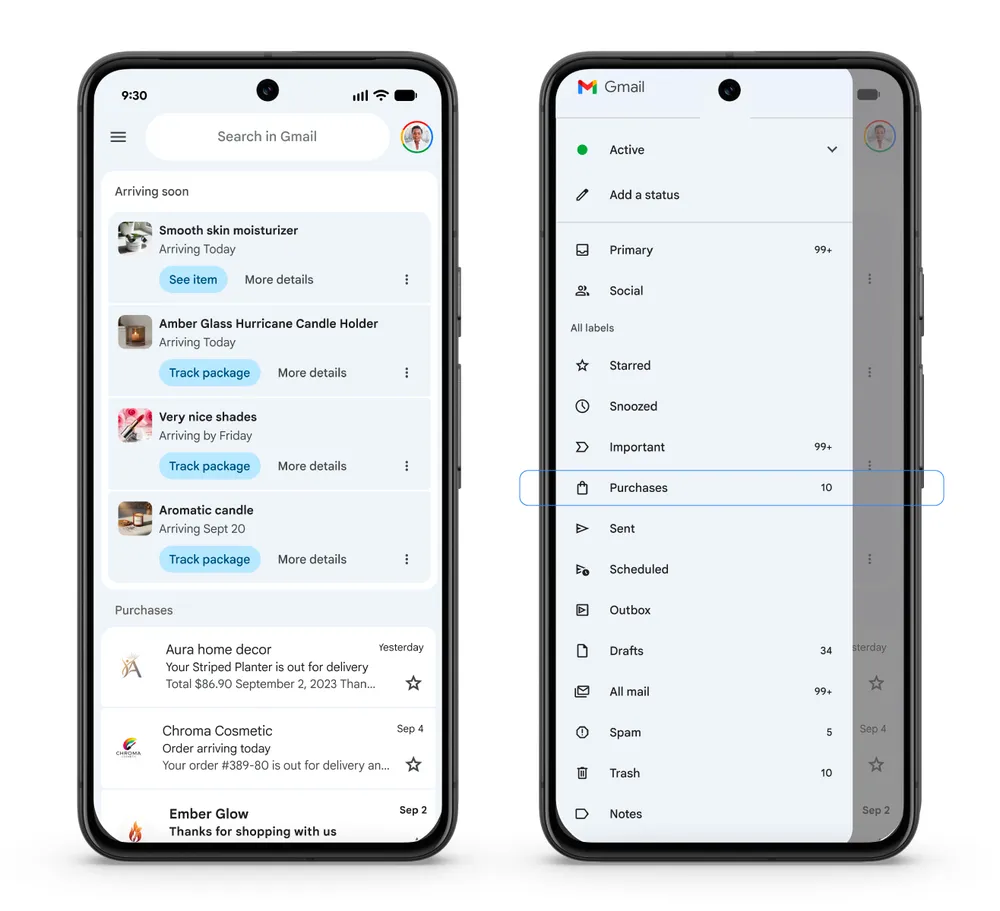Drive sales on autopilot with ecommerce-focused features
See FeaturesGoogle has been making some big moves that will have a direct impact on the email marketing industry. In this article, we’ll take a look at the latest Gmail feature updates and their implications, including insights from Omnisend’s Senior Deliverability and Compliance Manager, Boris Pavlov, and also discuss Google retiring v1 of Postmaster Tools.
So what’s changing in Gmail?
Google has now mostly completed rolling out three significant changes that affect how people interact with your emails:
- New Manage subscriptions view
- New Purchases view
- A more relevant Promotions tab
But don’t hit the panic button just yet. These changes aren’t here to ruin your open rates — they’re here to make the inbox a little less chaotic (for everyone, including you). In fact, they might even help you streamline your marketing and build a more engaged subscriber list.
The new Manage subscriptions view: A reality check for frequent senders
The most notable change is the new Manage Subscriptions view, which allows users to manage all their subscriptions from a single place. It shows recent send frequency for each brand and enables a one-click unsubscribe for each sender.
In short, users will see a list of senders ranked by how frequently they’ve emailed recently, from the most active to the least. Unsubscribing there will remove a person from all active mailing lists associated with that sender.
The high-volume senders at the top are the most visible and therefore at the biggest risk of being pruned.
Our take
According to Omnisend’s internal data, we’ve seen a platform-wide increase in unsubscribes since July, when Google began rolling out this feature globally. So, how can you avoid getting hit?
“Send fewer, but more relevant and important messages — and make sure your segmentation is spot on,” explains Boris Pavlov, Senior Deliverability and Compliance Manager at Omnisend. “This is a great reminder for senders to be mindful of their sending frequency. If you send 20+ emails a month that your subscribers never engage with, you’re likely pushing them toward unsubscribing and causing recipient fatigue.”
The new Purchases view: Why you should keep your receipts clean

The new Purchases view brings all purchase-related updates together in one place, for the first time, including receipts, shipping notifications, and order updates.
What’s especially useful for users is that the new view also highlights, in scannable cards at the top, packages arriving soon.
Our take
“The message to senders is simple,” explains Boris Pavlov. “Don’t mix transactional content with promotional. Turning an order receipt into a marketing email isn’t just a bad practice — it can cause compliance issues and negative engagement that could hurt your deliverability.”
For example, suppose your order confirmation includes a large banner promoting another product or a discount code, but the customer hasn’t explicitly agreed to receive promotional content. In that case, you could be running into a compliance issue. As a result, Gmail may no longer treat it as a purely transactional message. That means it could fall outside the Purchases view or even affect your deliverability if recipients start ignoring or marking it as spam.
To make sure Gmail correctly classifies your messages as purchase-related, be consistent and focus on their utility: use a recognizable sender name, predictable subject lines (“Your order confirmation” or “Your receipt”), and clear, structured order details.
Promotions tab getting smarter: Relevance as the new default
Instead of showing emails in strict chronological order, Gmail’s Promotions tab now prioritizes what it thinks users actually care about by default, based on engagement.
Personal accounts will see messages sorted by relevance rather than recency, along with a new “Top deals for you” section and gentle reminders, which Google calls “nudges”, about limited-time offers.
Our take
“This isn’t a minor update,” explains Boris Pavlov. “With Most relevant as the default, the brands people actually engage with will appear at the top. It’s a clear reminder that quality beats quantity: send content people genuinely want, and avoid waking up lists that haven’t heard from you in years — those subscribers have probably forgotten they ever signed up.”
In other words, now more than ever, visibility in the Promotions tab is earned through consistent, meaningful engagement. When subscribers open, click, or save your campaigns, Gmail learns to surface you higher. But if you keep blasting generic offers to unengaged contacts, your emails will quietly slide down — or vanish altogether.
Every send should build trust. Focus on recent activity, tailor content to customer interests, and re-engage dormant subscribers thoughtfully.
What to keep an eye on
If you’re already sending messages with clear value, expect limited impact. To monitor the situation, we recommend watching churn by segments and unsubscribe rates by inbox provider.
From a sender’s perspective, the focus should shift from asking, “Did all messages get delivered?” or “Were we able to send to every address on our list for this new promotion?” to asking, “Is this content visible and personalized?” and “Does this content truly deliver value to my customer?”
It’s more important than ever to pay attention to the signals your audience gives you — using those insights to tailor future campaigns, meet their needs, and consistently provide real value.
“Trust is built through transparency,” says Boris Pavlov. “Your recipients need to trust you in order for your emails to reach the inbox and for your business to grow. To maintain transparency as a sender, make sure the purpose behind your campaigns is clearly communicated, and clearly separate your promotional and transactional traffic.
Put yourself in your recipient’s shoes and double-check whether anything in your new template might come across as misleading — and replace it with honesty.
The trust of your customers is the single most powerful factor that drives business growth and fuels successful campaigns in the highest ROI messaging channel in history.”
To sum up, those who focus on transparency, relevance, and genuine value are likely to come out ahead. These updates reward quality senders, those who communicate clearly, respect preferences, and send content that people actually want to open.
Think of these changes as Gmail helping clean up the playing field. Brands that treat subscribers like humans, not data points, will actually see stronger engagement as clutter and noise get filtered out. In other words, good email marketing just got a little more rewarding.
You should also know: Google is deprecating the Postmaster Tools v1
Google has officially started the deprecation process of Postmaster Tools v1. The rollout is gradual — some senders are already being redirected to Postmaster Tools v2, while others may still see the old dashboard for now. Full deprecation is expected by the end of the year. Here’s a brief overview of what it means:
- Domain & IP reputation dashboards are no longer available. But you can still review compliance status, spam rate trends, and delivery errors.
- v2 API will replace v1, expected before the end of 2025. According to Google, “The new (v2) API will encompass all existing v1 functionality, except Domain and IP reputation. It will also offer more useful endpoints, including compliance status, Domain Management APIs, and Batch APIs.”
- The compliance dashboard has been redesigned. It now includes clear horizontal markers at the 0.1% suggested spam rate and the 0.3% policy threshold, making it easier to spot potential issues at a glance.
Additionally, starting in November 2025, Gmail is intensifying its enforcement against non-compliant email traffic. Messages that don’t meet sender requirements may face disruptions, including temporary or even permanent rejections.
Key takeaways
The shift in the industry is stronger and more visible than ever. Recent changes and updates to the mailbox experience clearly indicate that only senders who consistently deliver genuine value to their recipients will secure a lasting place in the inbox. The days when generic promotional content and a long recipient list were enough to run a campaign are long gone.
To succeed, senders must focus on several key aspects:
- Build your contact base clearly and transparently. How you collect your contacts matters more than ever. Clear consent and transparency are the foundation of lasting deliverability.
- Quality over quantity. Sending emails that are expected, relevant, and wanted is essential. Otherwise, your entire email program risks being filtered into oblivion.
- Separate your email streams. Maintain a clear distinction between promotional and transactional emails to stay compliant and protect your sender reputation. Promotional content should never appear in transactional messages.
- Know and engage your active audience. Analyze engagement data to understand who your active subscribers are, and tailor future communication to their interests to keep your content relevant and valuable.
- Create a dedicated Sunset Policy flow. This will help keep your contact list free from lost cause contacts that can only harm your reputation as a sender.
Staying ahead in email marketing isn’t about sending more — it’s about sending better.
TABLE OF CONTENTS
TABLE OF CONTENTS


No fluff, no spam, no corporate filler. Just a friendly letter, twice a month.

 OFFER
OFFER







